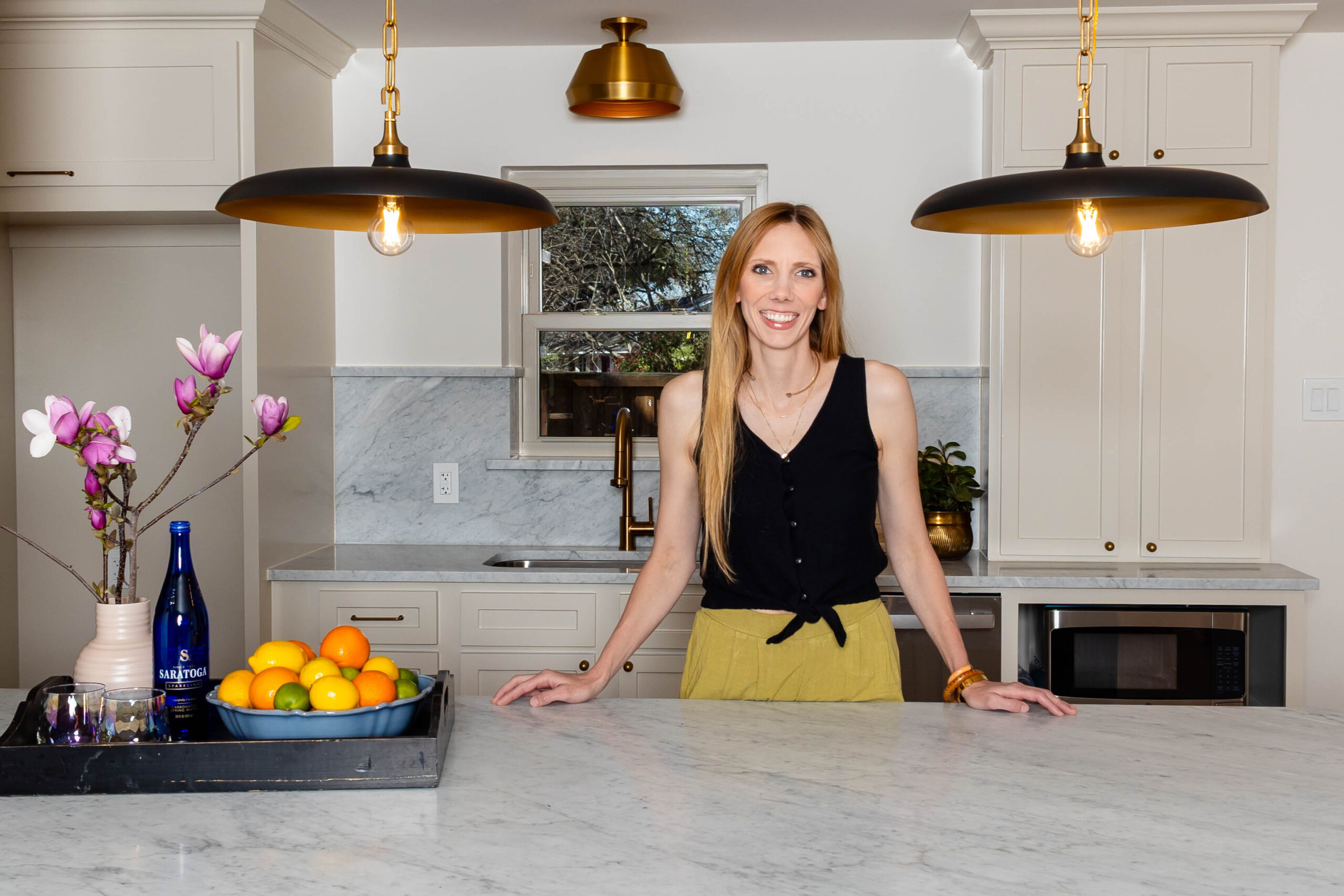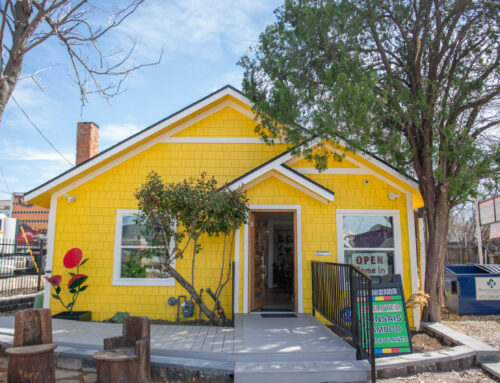
Photography by Amani Sodiq
The teardown is, and has been for the last few years, -in- in Lake Highlands.
In neighborhoods like the L Streets and White Rock Valley, the single-story ranch homes that dominate the area are falling in place of imposing, two-story white edifices.
But not everyone is starting from scratch.
McKenzie Schimming Button is a Lake Highlands native and neighbor who buys, remodels and flips homes in the area. Her projects vary widely in scale, but she says she has a vested interest in preserving existing features.
Both of her parents did the exact same thing in the exact same area. Traveling from project to project in Hollywood Hills with her father, with whom she still works, Button grew to appreciate real estate, home design and preservation.
As single-story homes tumble down around the neighborhood, we caught up with McKenzie to learn more about making something old new again.
You grew up in the business, correct?
My dad started out as a real estate agent with Henry S. Miller. Like in the ’70s. He did that for a while, and he started buying rental properties, and then he started improving, basically flipping before anybody really did that. He worked a lot in Santa Monica, Hollywood Heights, down there with the historic homes so I remember being brought down there to kind of look at the project and mess around on piles of dirt and all that. My mom would kind of help him come up with a design, and then they would execute it. I sort of started doing it on my own, and then I started helping him. So anyway, we just buy the distressed property and basically improve it from the ground up, and we do it together, and it’s just something that we enjoy doing a lot of times. It’s just about the beauty of it. My dad was a history major, so taking something that’s old and making it look good again.
Why does preserving older homes interest you so much?
I don’t know if it was just something that I was kind of raised around, like I said, my parents both appreciate history. I was always taught to appreciate history, and I feel kind of bad saying this, but I really haven’t had as much of an opportunity or ability to preserve things in a way that I wanted to until recently, which is more something that I’m trying to focus on in the last couple years. But I do think Dallas has a really bad track record, in general, of just not appreciating the things that we have and turning them into trash and bulldozing them.
Are there any projects you are working on that you are excited about?
I am really into the one that I’m doing right now. I just started, so there’s not a lot to see. But I haven’t done anything in this vein for a while. I’ve been doing things more traditional-ish, but this one I’m going to do more like, I hate to use the word mid-century modern, because people throw it around, and it’s not really mid-century modern. But that flavor, I want to say ‘groovy,’ is what I want it to be, kind of like fun and a nod back to the time that the building was created in. That’s actually something that I do focus on a lot in my projects, is I try to find something in the house to start with that kind of speaks to me and tells me, ‘OK, what direction does this need to go?’ Rather than just kind of regurgitating the same white box that everybody else does. That’s not to say that we don’t paint things white, we do, but sometimes they’re not. Sometimes I keep the brick.

Photography by Amani Sodiq
What architectural styles do you work with?
It would be fun to do the Tudor craftsman stuff, but generally, the neighborhoods that we work in, I’m getting the same kind of single-story ranch that can be a bit of a blank slate in a way. It’s so nice when you can have something that is good to keep. Sometimes I get bogged down in the possibility of what could be, and I’ll sit around and be like, ‘Oh, I could do this, or I could do this, or I see something here,’ and I keep it in my head for later, but I get overwhelmed with the preparation of, ‘Oh, what direction am I taking this in?’ And so that’s why sometimes it’s nice to have the architecture kind of speak to you. But generally, there’ll be something in the architecture to help you bring the ranch style into a style. It can be a bit of a bland architecture without being brought to life in one way or another. Although saving the elements of the bathrooms and stuff has kind of helped me perk that up a little bit and keep it in that style. And the nice thing about those is a lot of times they do have the original hardwoods, and we always save those if they’re there.
What advice would you give to someone looking to remodel or add onto a Lake Highlands ranch home?
I think it’s good for people to know that a lot of these houses are from the 1950s and 1960s. I think people resent house flipping a lot because there’s a lot of bad quality flippers. But a lot of these homes need to be at this point, they really need to be worked over. A lot of the gas lines that we see are bad. I mean, a lot of them, most of the wiring, a lot of this stuff is really reaching the end of its useful life. So, just to be cautious about that, and then the space itself really, you can’t go wrong with most of these. It’s nice once you get to a certain building period year, like the ’70s, then you start getting an actual master built, or primary suite built into the floor plan, which, if you want to take on a big remodel, will make the process cheaper and easier. If you work over in Lake Highlands with more of a traditional ranch house of the ’50s or ’60s, they weren’t built with that. They had three bedrooms, the whole bathroom and then maybe a Jack and Jill. So when you’re biting that off, you’re really looking into something like consolidating the bedrooms or adding space if you want a more modernized layout.
Are there any current design trends you enjoy?
I know that marble has been king for a while, and I am a big fan. It’s going to stand the test of time. If you choose an actual, real material versus going to a big box or whatever and get a porcelain tile with a fake pattern, you’re gonna get longevity out of stuff like that. I do think people are doing a lot of quartzite right now. I’m kind of concerned that they’re using the same pattern over and over. So I don’t know if I would bite that off in my own house, because it’s expensive, and I fear that it’ll become a kind of capsule specific to a period of time.
As someone who is in real estate and grew up in Lake Highlands, how do you feel about the teardowns?
So initially, I was really resistant to it because I also went to Lake Highlands, I was born here. My husband went to Lake Highlands as well. So we’re those people and it is hard. I mean, change is hard, and sometimes it does feel like unnecessary waste and kind of taking the character out of an area, but I recognize that a lot of the layouts and a lot of the space constraints are not conducive to what people want at the present time. Sometimes to me, it feels a bit excessive. I enjoy light, I enjoy gardens, I enjoy outdoor space. So it’s sort of hard for me to personally fathom taking a lot and building as much house as possible and not leaving any room outside. But as time goes on, I think there are some other builders who have come in since those who originally started to be a big deal in this area, who do have better taste and better vision for design in general. So it’s a little easier to watch them go down when they come back up.
This interview has been edited for clarity and brevity.





